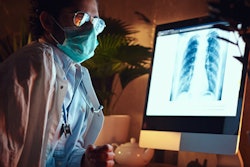
The Society of Nuclear Medicine and Molecular Imaging (SNMMI) has updated its recommendations regarding COVID-19 vaccinations to help prevent misinterpretation of FDG-PET/CT images, according to a statement released March 30.
Radiologists are encountering transient FDG uptake in normal or enlarged axillary, supraclavicular, and cervical lymph nodes after vaccination in the ipsilateral deltoid muscle. Reactive lymphadenopathy has been reported in up to 16% of patients following COVID-19 vaccination with the mRNA (Pfizer/BioNTech, Moderna) vaccines. No evidence has been reported of the side effect to date in patients receiving the adenovirus vector vaccine (Janssen/Johnson & Johnson).
Since the phenomenon may confound image interpretation in oncology patients undergoing FDG-PET/CT scans, the SNMMI has made the following recommendations:
- Recognize that FDG-avid lymphadenopathy can occur in the axillary (and possibly lower cervical/supraclavicular) stations ipsilateral to the site of injection and can be seen for four to six weeks or longer after the most recent dose of vaccine.
- Patient questionnaires should be revised to include information about the dates and sites of vaccination and which vaccine was administered.
- For patients with a history of breast and head and neck cancers, the vaccine should be administered in the contralateral arm whenever possible.
The National Comprehensive Cancer Network currently recommends delaying imaging by four to six weeks following the COVID-19 vaccine if it will not affect patient outcomes. No evidence yet suggests whether delaying imaging by six weeks after the second dose of COVID-19 vaccine is sufficient to ensure resolution of FDG-avid lymphadenopathy.



















